Enhancement of Magnetic and Tensile Mechanical Performances in Fe-Based Metallic Microwires Induced by Trace Ni-Doping
Abstract
:1. Introduction
2. Materials and Methods
3. Results
3.1. Microstructure and Magnetic Properties of Fe-Based Metallic Microwires
3.2. Tensile Properties and Fracture Morphology of Fe-Based Metallic Microwires
4. Conclusions
Author Contributions
Funding
Institutional Review Board Statement
Informed Consent Statement
Data Availability Statement
Conflicts of Interest
References
- Silveyra, J.M.; Ferrara, E.; Huber, D.L.; Monson, T.C. Soft magnetic materials for a sustainable and electrified world. Science 2018, 362, eaao0195. [Google Scholar] [CrossRef] [Green Version]
- Yi, J.; Xia, X.X.; Zhao, D.Q.; Pan, M.X.; Bai, H.Y.; Wang, W.H. Micro-and nanoscale metallic glassy fibers. Adv. Eng. Mater. 2010, 12, 1117–1122. [Google Scholar] [CrossRef]
- Inoue, A. Stabilization of metallic supercooled liquid and bulk amorphous alloys. Acta Mater. 2000, 48, 279–306. [Google Scholar] [CrossRef]
- Liu, J.S.; Li, Z.; Shen, H.X.; Qin, F.X.; Jiang, S.D.; Du, Z.X.; Phan, M.-H.; Sun, J.F. Composite electroplating to enhance the GMI output stability of melt-extracted wires. Mater. Des. 2016, 96, 251–256. [Google Scholar] [CrossRef]
- Arzuza, L.C.C.; Béron, F.; Pirota, K.R. High-frequency GMI hysteresis effect analysis by first-order reversal curve (FORC) method. J. Magn. Magn. Mater. 2021, 534, 168008. [Google Scholar] [CrossRef]
- Zhan, Y.S.; Lin, C.-H. Micromechanics-based constitutive modeling of magnetostrictive 1-3 and 0-3 composites. Compos. Struct. 2021, 260, 113264. [Google Scholar] [CrossRef]
- Qin, F.X.; Peng, H.-X. Ferromagnetic microwires enabled multifunctional composite materials. Prog. Mater. Sci. 2013, 58, 183–259. [Google Scholar] [CrossRef]
- Liu, J.S.; Qu, G.D.; Wang, X.F.; Chen, H.N.; Zhang, Y.; Cao, G.Y.; Liu, R.; Jiang, S.D.; Shen, H.X.; Sun, J.F. Influence of Fe-doping amounts on magnetocaloric properties of Gd-based amorphous microfibers. J. Alloys Compd. 2020, 845, 156190. [Google Scholar] [CrossRef]
- Shen, H.X.; Luo, L.; Xing, D.W.; Jiang, S.D.; Liu, J.S.; Huang, Y.J.; Guo, S.; Sun, H.C.; Liu, Y.F.; Sun, J.F.; et al. The magnetocaloric composite designed by multi-Gd-Al-Co microwires with close performances. Phys. Status Solidi A. 2019, 216, 1900090. [Google Scholar] [CrossRef]
- Zheng, X.F.; Qin, F.X.; Wang, H.; Mai, Y.-W.; Peng, H.X. Microwave absorbing properties of composites containing ultra-low loading of optimized microwires. Compos. Sci. Technol. 2017, 151, 62–70. [Google Scholar] [CrossRef]
- Wang, X.D.; Liu, J.S.; Qin, F.X.; Wang, H.; Xing, D.W.; Sun, J.F. Microwave absorption properties of FeSiBNbCu glass-covered amorphous wires. Trans. Nonferrous Met. Soc. China 2014, 24, 2574–2580. [Google Scholar] [CrossRef]
- Sun, X.L.; Jie, J.C.; Wang, T.M.; Li, T.J. Effect of two-step cryorolling and aging on mechanical and electrical properties of a Cu–Cr–Ni–Si alloy for lead frames applications. Mater. Sci. Eng., A 2021, 809, 140521. [Google Scholar] [CrossRef]
- Chao, S.-C.; Huang, W.-C.; Liu, J.-H.; Song, J.-M.; Shen, P.-Y.; Huang, C.-L.; Hung, L.-T.; Chang, C.-H. Oxidation characteristics of commercial copper-based lead frame surface and the bonding with epoxy molding compounds. Microelectron. Reliab. 2019, 99, 161–167. [Google Scholar] [CrossRef]
- Meng, F.Q.; Tsuchiya, K.S., II; Yoshihiko, Y. Reversible transition of deformation mode by structural rejuvenation and relaxation in bulk metallic glass. Appl. Phys. Lett. 2012, 101, 121914. [Google Scholar] [CrossRef]
- Wang, Y.B.; Lee, C.C.; Yi, J.; An, X.H.; Pan, M.X.; Xie, K.Y.; Liao, X.Z.; Cairney, J.M.; Ringer, S.P.; Wang, W.H. Ultrahigh-strength submicron-sized metallic glass wires. Scr. Mater. 2014, 84, 27–30. [Google Scholar] [CrossRef]
- Li, Z.Z.; Zhou, S.X.; Zhang, G.Q.; Zheng, W. Highly ductile and ultra-thick P-doped FeSiB amorphous alloys with excellent soft magnetic properties. Mater. 2018, 11, 1148. [Google Scholar] [CrossRef] [PubMed] [Green Version]
- Wang, A.D.; Zhao, C.L.; Men, H.; He, A.N.; Chang, C.T.; Wang, X.M.; Li, R.-W. Fe-based amorphous alloys for wide ribbon production with high Bs and outstanding amorphous forming ability. J. Alloys Compd. 2015, 630, 209–213. [Google Scholar] [CrossRef]
- Shi, Z.G.; Li, R.; Zhang, T. Tunable magnetic properties and heat-treatable bending ductility of Fe-Co-B-P-C amorphous alloys with a high saturated magnetization up to 1.79 T. J. Alloys Compd. 2019, 778, 302–308. [Google Scholar] [CrossRef]
- Zhang, Y.; Wang, Z.; Li, X.-H.; Hao, Q.-Q.; Shi, R.-M. Effect of annealing temperature on structure and high-temperature soft magnetic properties of (Fe0.9Co0.1)72.7Al0.8Si13.5Cu1Nb3B8V1 nanocrystalline alloy. Mater. Res. Bull. 2021, 138, 111212. [Google Scholar] [CrossRef]
- Wang, C.X.; Wu, Z.Y.; Feng, X.M.; Li, Z.; Gu, Y.; Zhang, Y.; Tan, X.H.; Xu, H. The effects of magnetic field annealing on the magnetic properties and microstructure of Fe80Si9B11 amorphous alloys. Intermetallics 2020, 118, 106689. [Google Scholar] [CrossRef]
- Jiang, S.D.; Wang, H.; Huang, Y.J.; Shen, H.X.; Xing, D.W.; Ning, Z.L.; Sun, J.F. Effect of strain rate on tensile behavior in amorphous fibers by an in-situ video extensometer system. Mater. Sci. Eng. A 2020, 782, 139252. [Google Scholar] [CrossRef]
- Liu, J.S.; Zhang, Y.; Wang, Q.X.; Wu, M.J.; Nan, D.; Shen, H.X.; Peng, H.X. Enhanced tensile properties, and fracture reliability of Cu-based amorphous wires via Pr-doping. Adv. Eng. Mater. 2018, 20, 1700935. [Google Scholar] [CrossRef]
- Chiriac, H.; Lupu, N.; Dobrea, V.; Corodeanu, S. Mechanical properties of magnetic Fe-based and Co-based amorphous wires and microwires. Phys. Status Solidi A 2009, 206, 648–651. [Google Scholar] [CrossRef]
- Chen, S.S.; Zhang, H.R.; Todd, I. Phase-separation-enhanced plasticity in a Cu47.2Zr46.5Al5.5Nb0.8 bulk metallic glass. Scr. Mater. 2014, 72–73, 47–50. [Google Scholar] [CrossRef]
- Wu, Y.; Wu, H.H.; Hui, X.D.; Chen, G.L.; Lu, Z.P. Effects of drawing on the tensile fracture strength and its reliability of small-sized metallic glasses. Acta Mater. 2010, 58, 2564–2576. [Google Scholar] [CrossRef]
- Chen, H.; Zhou, S.X.; Dong, B.S.; Jin, J.J.; Liu, T.Q.; Guan, P.F. A general rule for transition metals doping on magnetic properties of Fe-based metallic glasses. J. Alloys Compd. 2019, 819, 153062. [Google Scholar] [CrossRef]
- Ding, S.; Liu, M.; Wang, Z.Y.; Wang, Z.M.; Wang, B.J.; Zhou, D.; Jin, M.L.; Sun, Y.L.J. Structural and Magnetic Characterization of Fe-Based Amorphous Alloy Prepared by Microwave Annealing Treatment. Electron. Mater. 2020, 49, 2402–2405. [Google Scholar] [CrossRef]
- Lee, Y.J.; Jeon, J.Y.; Nam, S.J.; Jang, T.; Kim, H.J.; Lee, M.W.; Kim, Y.J.; Yang, D.Y.; Min, K.S.; Choi, H.J. Soft magnetic properties of Fe-based amorphous/nanocrystalline hybrid materials. Powder Technol. 2018, 339, 440–445. [Google Scholar] [CrossRef]
- Cheng, C.J.; Xiao, Y.; Haché, M.J.R.; Liu, Z.Y.; Wheeler, J.M.; Zou, Y. Probing the small-scale plasticity and phase stability of an icosahedral quasicrystali-Al-Pd-Mn at elevated temperature. Phys. Rev. Mater. 2021, 5, 053602. [Google Scholar] [CrossRef]
- Huang, H.; Jiang, M.Q.; Yan, J.W. New evidences for understanding the serrated flow and shear band behavior in nanoindentation of metallic glasses. J. Alloys Compd. 2021, 857, 157587. [Google Scholar] [CrossRef]
- Liu, L.F.; Dai, L.H.; Bai, Y.L.; Ke, F.J. Comparison of shear banding in BMGs due to thermal-softening and free volume creation. Sci. China Ser. G Phys. Mech. Astron. 2008, 51, 1367–1379. [Google Scholar] [CrossRef]
- Zeng, F.; Jiang, M.Q.; Dai, L.H. Dilatancy induced ductile-brittle transition of shear band in metallic glasses. Proc. R. Soc. A 2018, 474, 20170836. [Google Scholar] [CrossRef] [PubMed]
- Zhang, Z.F.; He, G.; Eckert, J.; Schultz, L. Fracture Mechanisms in Bulk Metallic Glassy Materials. Phys. Rev. Lett. 2003, 91, 045505. [Google Scholar] [CrossRef]
- Huang, Y.J.; Shen, J.; Sun, J.F. Bulk metallic glasses: Smaller is softer. Appl. Phys. Lett. 2007, 90, 081909. [Google Scholar] [CrossRef]
- Wang, H.; Xing, D.W.; Peng, H.X.; Qin, F.X.; Cao, F.Y.; Wang, G.Q.; Sun, J.F. Nanocrystallization enabled tensile ductility of Co-based amorphous microwires. Scr. Mater. 2012, 66, 1041–1044. [Google Scholar] [CrossRef]
- Spaepen, F. A microscopic mechanism for steady state inhomogeneous flow in metallic glasses. Acta Metall. 1977, 25, 407–415. [Google Scholar] [CrossRef]
- Lee, C.J.; Huang, J.C.; Nieh, T.G. Sample size effect and microcompression of Mg65Cu25Gd10 metallic glass. Appl. Phys. Lett. 2007, 91, 161913. [Google Scholar] [CrossRef]
- Liu, J.S.; Pang, M.Y.; Cao, G.Y.; Qu, G.D.; Wang, X.F.; Zhang, Y.; Liu, R.; Shen, H.X. Comparative study of tensile properties and magnetic properties for Nb-doped Fe-based wires. J. Mater. Res. Technol. 2020, 9, 12907–12916. [Google Scholar] [CrossRef]
- Own, S.H.; Subramanian, R.V.; Saunders, S.C. A bimodal Iognormal model of the distribution of strength of carbon fibres: Effects of electrodeposition of titanium di (dioctyl pyrophosphate) oxyacetate. J. Mater. Sci. 1986, 21, 3912–3920. [Google Scholar] [CrossRef]
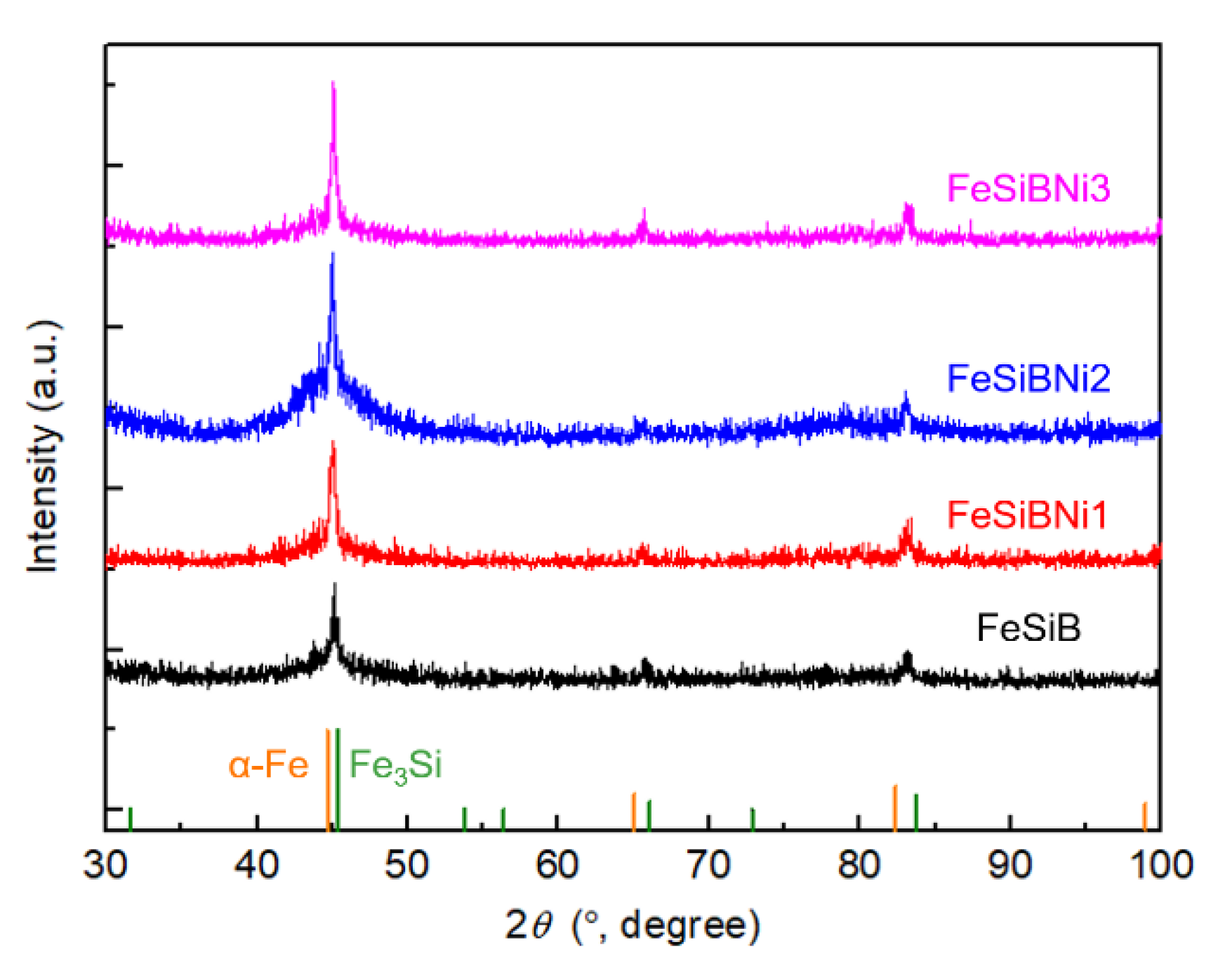
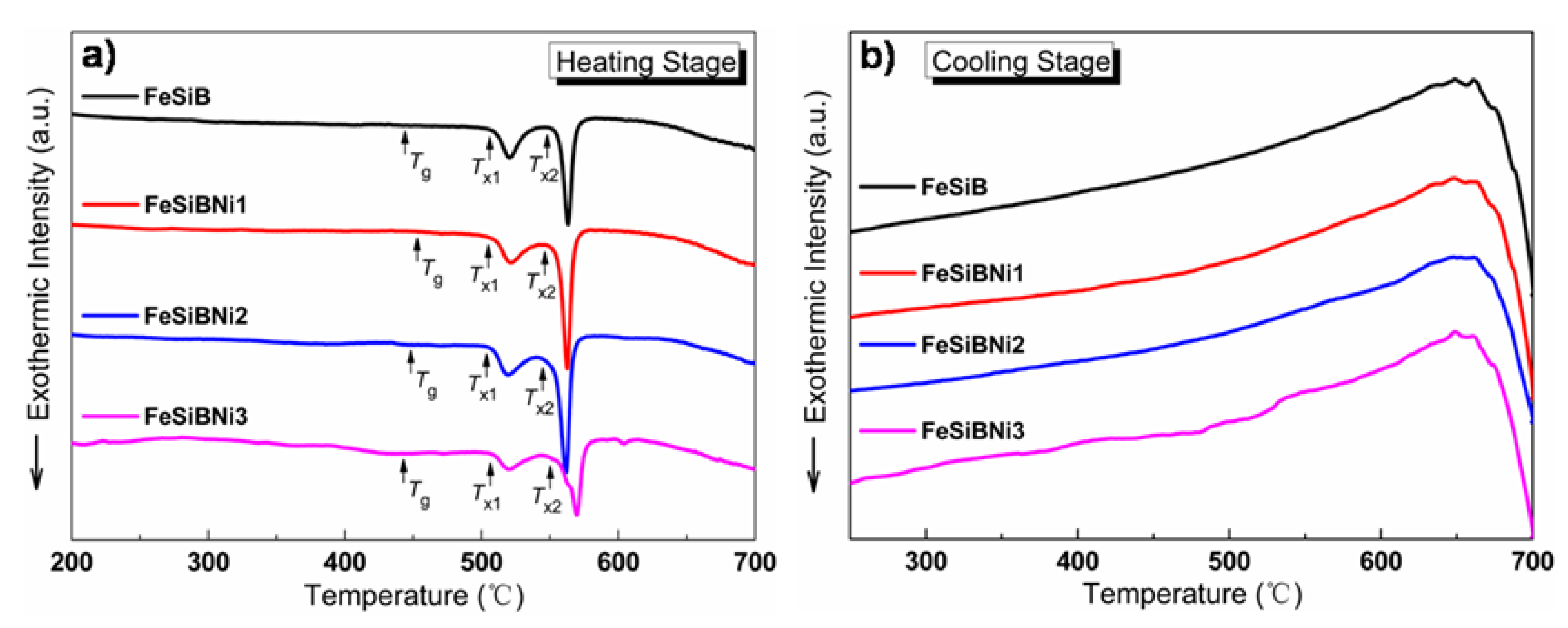

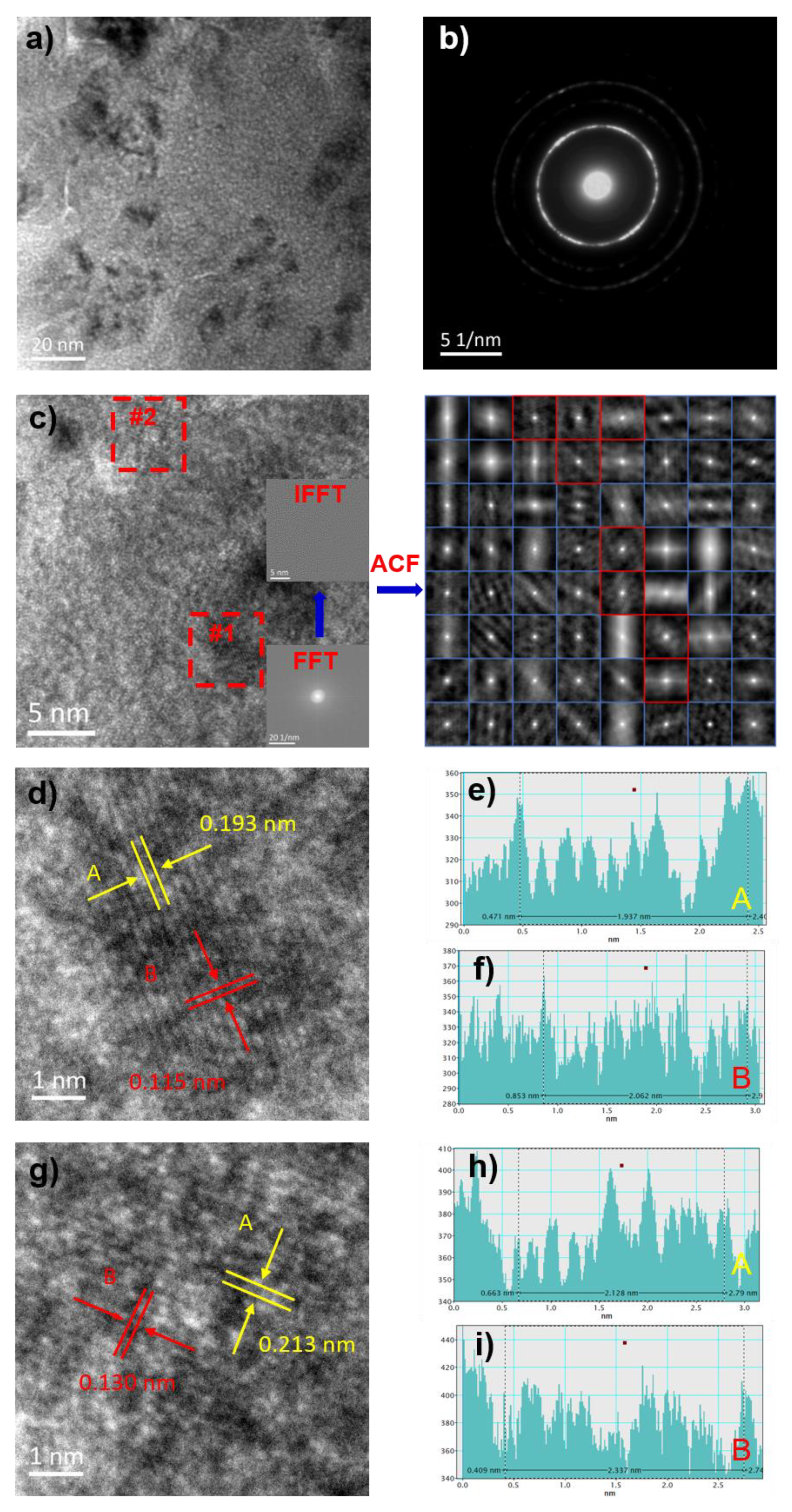
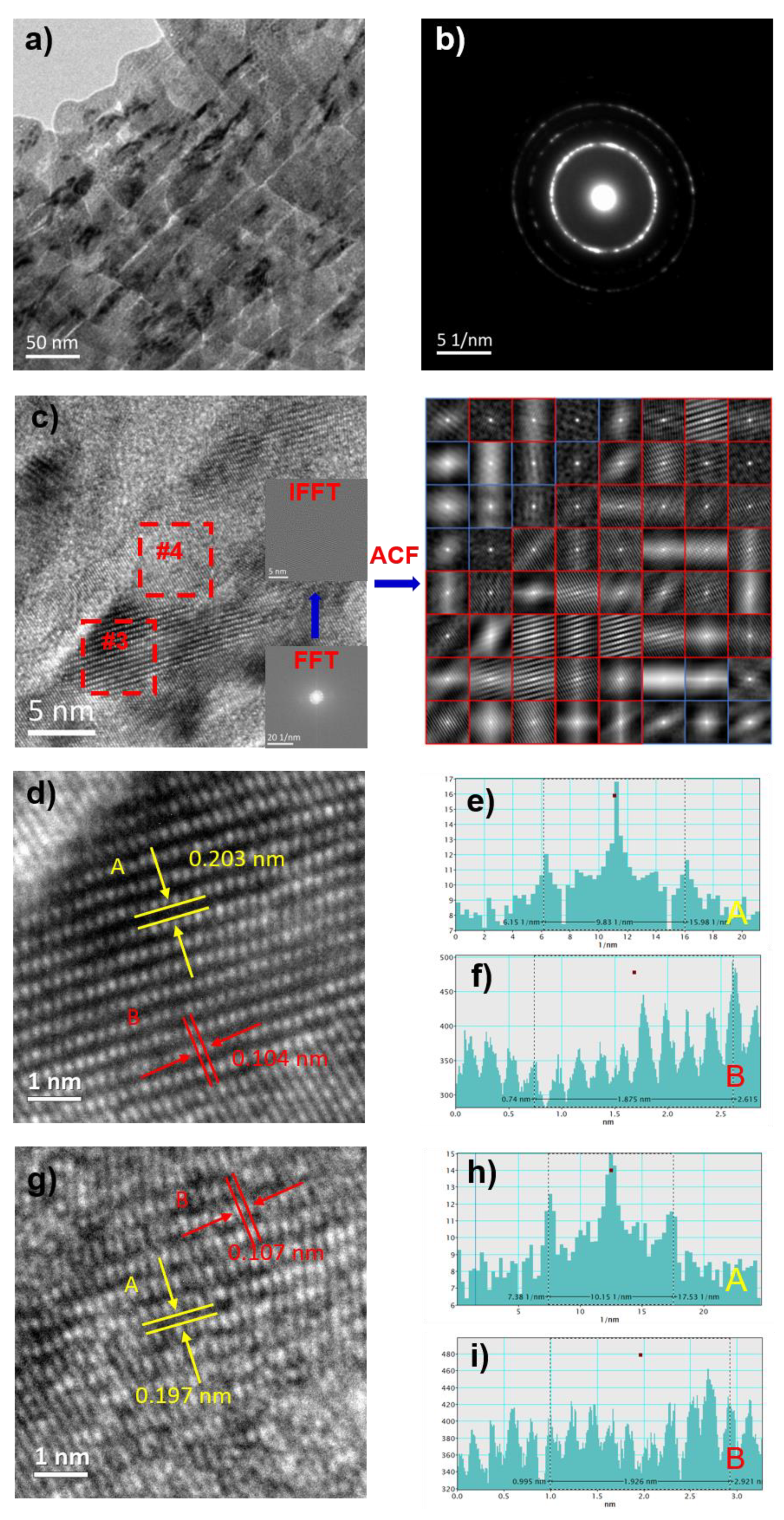
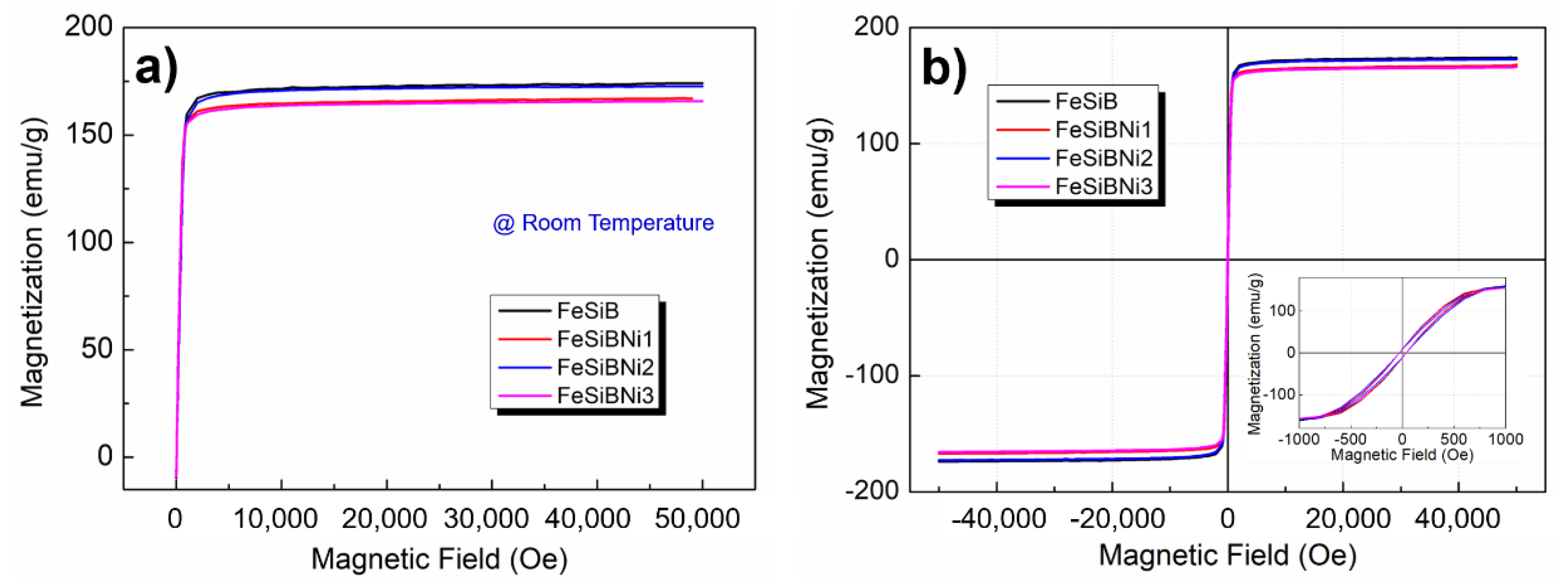


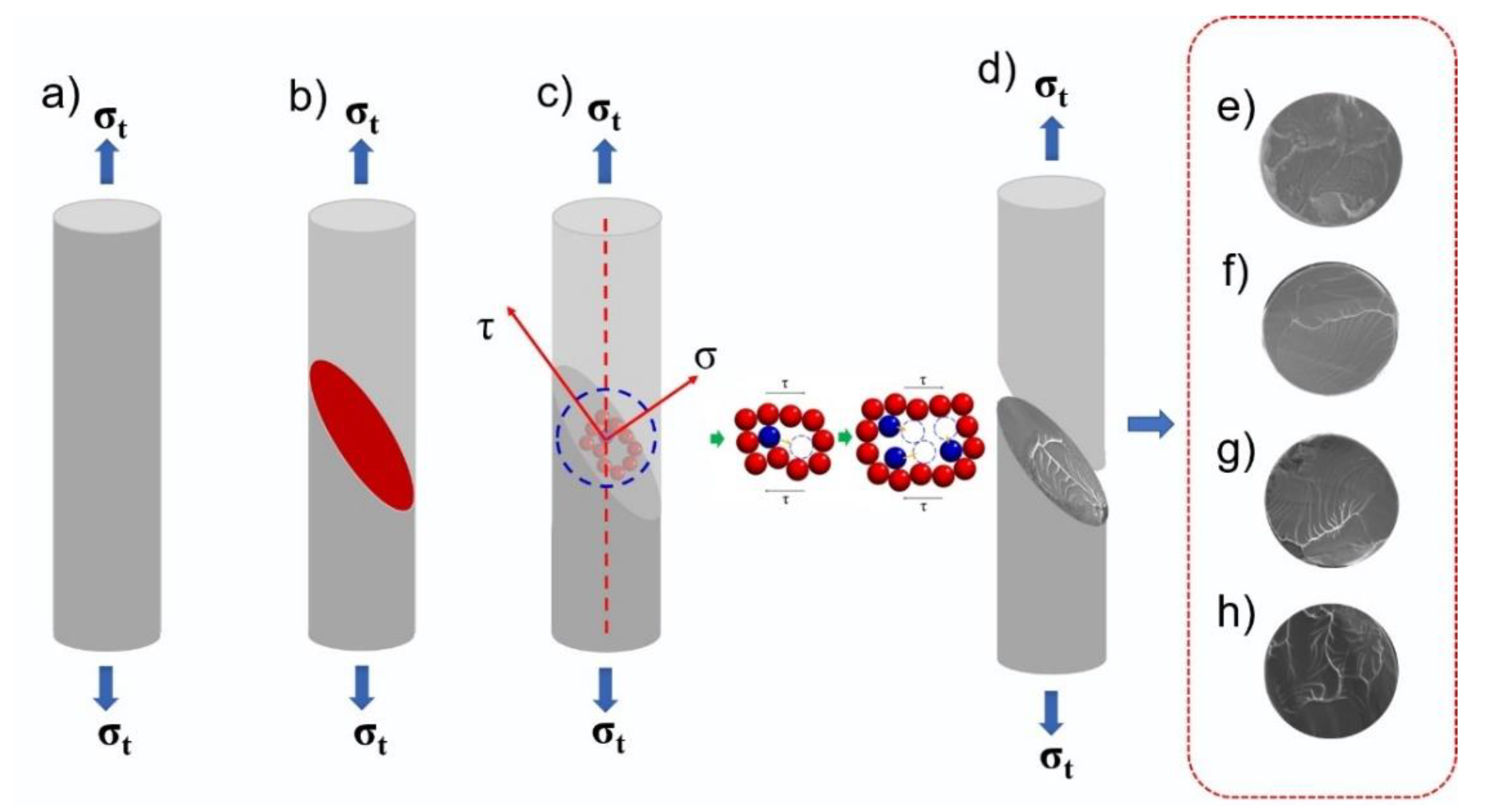
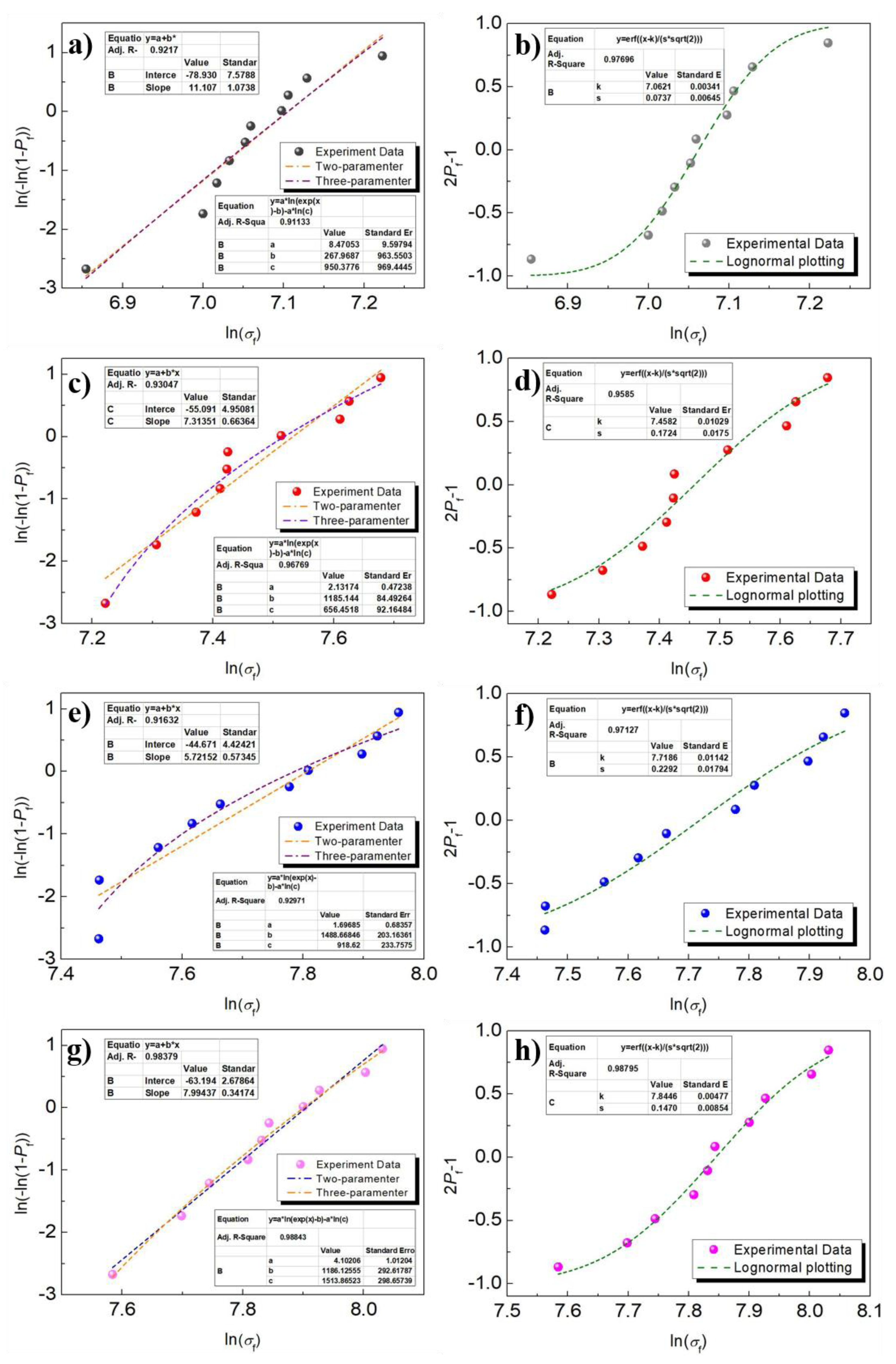
| Abbreviations of Wire Composition | Tg (°C) | Tx1 (°C) | Tx2 (°C) | ΔT (°C) | −ΔH (J/g) |
|---|---|---|---|---|---|
| FeSiB | 438.41 | 504.71 | 541.32 | 66.30 | 51.30 |
| FeSiBNi1 | 447.46 | 502.92 | 551.38 | 55.46 | 56.11 |
| FeSiBNi2 | 443.29 | 506.27 | 546.54 | 62.98 | 59.30 |
| FeSiBNi3 | 441.81 | 503.94 | 538.16 | 62.13 | 43.14 |
| Abbreviations of Wire Composition | Ms (emu/g) | Mr (emu/g) | Hc (Oe) | μm |
|---|---|---|---|---|
| FeSiB | 174.06 | 10.82 | 33.08 | 0.43 |
| FeSiBNi1 | 167.04 | 10.25 | 32.77 | 0.32 |
| FeSiBNi2 | 172.70 | 9.68 | 31.97 | 0.40 |
| FeSiBNi3 | 165.81 | 10.79 | 32.47 | 0.33 |
| Fitting Type | FeSiB | FeSiBNi1 | FeSiBNi2 | FeSiBNi3 | |
|---|---|---|---|---|---|
| Weibull statistics | two-parameter | m = 11.11 | m = 7.31 | m = 5.72 | m = 7.99 |
| three-parameter | m = 8.47 | m = 2.13 | m = 1.69 | m = 4.10 | |
| σu = 267 MPa | σu = 1185 MPa | σu = 1488 MPa | σu = 1186 MPa | ||
| Lognormal plotting | k = 7.06215 | k = 7.45825 | k = 7.71868 | k = 7.84469 | |
| s = 0.07378 | s = 0.17246 | s = 0.22924 | s = 0.14708 | ||
Publisher’s Note: MDPI stays neutral with regard to jurisdictional claims in published maps and institutional affiliations. |
© 2021 by the authors. Licensee MDPI, Basel, Switzerland. This article is an open access article distributed under the terms and conditions of the Creative Commons Attribution (CC BY) license (https://creativecommons.org/licenses/by/4.0/).
Share and Cite
Zhang, M.; Qu, G.; Liu, J.; Pang, M.; Wang, X.; Liu, R.; Cao, G.; Ma, G. Enhancement of Magnetic and Tensile Mechanical Performances in Fe-Based Metallic Microwires Induced by Trace Ni-Doping. Materials 2021, 14, 3589. https://doi.org/10.3390/ma14133589
Zhang M, Qu G, Liu J, Pang M, Wang X, Liu R, Cao G, Ma G. Enhancement of Magnetic and Tensile Mechanical Performances in Fe-Based Metallic Microwires Induced by Trace Ni-Doping. Materials. 2021; 14(13):3589. https://doi.org/10.3390/ma14133589
Chicago/Turabian StyleZhang, Mingwei, Guanda Qu, Jingshun Liu, Mengyao Pang, Xufeng Wang, Rui Liu, Guanyu Cao, and Guoxi Ma. 2021. "Enhancement of Magnetic and Tensile Mechanical Performances in Fe-Based Metallic Microwires Induced by Trace Ni-Doping" Materials 14, no. 13: 3589. https://doi.org/10.3390/ma14133589
APA StyleZhang, M., Qu, G., Liu, J., Pang, M., Wang, X., Liu, R., Cao, G., & Ma, G. (2021). Enhancement of Magnetic and Tensile Mechanical Performances in Fe-Based Metallic Microwires Induced by Trace Ni-Doping. Materials, 14(13), 3589. https://doi.org/10.3390/ma14133589





